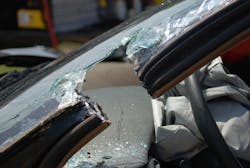University of Extrication: Dash & Instrument Panel Entrapment: Part 2
Topic: Dash roll or dash jacking evolution
Objective: Given an acquired vehicle to work with, the rescue team will better and successfully complete each step of the F-I-A-T procedure for dash rolling or dash jacking.
Task: Using rescue tools and equipment provided by the department, the rescue team will be able to complete the F-I-A-T procedure on an acquired vehicle and accomplish a successful dash rolling or dash jacking evolution.
To better remember the recommended steps of the dash entrapment procedure, the acronym F-I-A-T is offered. Not to be confused with the Fiat model of a car, F-I-A-T is an acronym to help crews remember four important points as they complete their dash tasks.
So, what does F-I-A-T stand for?
- F: The “F” stands for Fender, which must be moved to expose what is underneath.
- I: The “I” is for stored gas Inflators that may be nearby your cutting or ramming area.
- A: The “A” is for A-pillar cuts. Both the upper A-pillar and the lower A-pillar areas get cut.
- T: The “T” is for Tie-down, meaning the one or two metal supports that secure the dash structure to the floor of the vehicle.
In Part 1 of this article, we examined the first two steps in the F-I-A-T procedure. In Part 2, we examine the final two steps.
A-pillar cuts
The “A” of the F-I-A-T acronym is to remind us to make specific A-pillar cuts. Due to changes in vehicle design and construction, rescuers need to make these cuts at specific locations in both the upper A-pillar and lower A-pillar. It is important to note that to roll or jack a dash, the roof and the windshield do not have to be removed. Only the upper A-pillar, the portion along the edge of the windshield, really needs to be cut. The roof can be on and the windshield still in place.
To allow the sections of the A-pillar to be free of each other, the recommendation is to “double cut” or “chunk” the upper A-pillar with two cuts. Taking a section of the pillar out, or “chunking” the A-pillar, prevents the cut sections of the pillar from contacting each other and binding up as the dash moves.
For the lower A-pillar, the area below the level of the instrument panel, the rescue crew needs to decide on their dash extrication technique before any cuts are made. Dash jacking gets two parallel cuts through the A-pillar between the hinges so a section can be moved away to form a sort of “notch” for the spreader.
If dash rolling is the plan, then a horizontal cut completely through the lower A-pillar is needed. On modern vehicles, the horizontal cut should be below the bottom door hinge for best results—especially on a vehicle with a Boron A-pillar structure.
Start any lower A-pillar cut from the wheelwell side first and then make additional cuts working around to the door side of the pillar. This cutting sequence, different than what we have ever been trained to do in the past, will minimize the possibility of the cutter shifting inward and trapping the operator, the tool, or contacting against the patient.
In training with an undamaged car being cut apart, we typically are instructed to make cuts in the upper-rail structure. This will probably not be necessary at a real-world incident because the upper rail, a part of the crumple zone of the vehicle, would probably already be bent and mutilated if your patient is trapped. Cutting the upper rail is not a “must do” in most actual entrapment situations.
Tie-down release
The letter “T”, the final component of the F-I-A-T acronym, reminds rescue personnel to check for and cut the dash tie-downs, if possible. These are the one or two metal supports that secure the dash structure to the floor of the vehicle. If they are present and can be severed, the results of jacking or rolling will be greatly enhanced.
Use the F-I-A-T procedure in your dash extrication training and at real-world extrications. The four components are easy to remember, and it is very important that they are addressed, especially on a late-model vehicle with a patient trapped.
Sidebar
The F-I-A-T Procedure
F: Move the Fender
I: Check for stored gas Inflators
A: Cut both A-pillars
T: Secure your Tie-downs
About the Author
Ron Moore
RON MOORE, who is a Firehouse contributing editor, recently retired as a division chief with the McKinney, TX, Fire Department and now serves with Prosper, TX, Fire Rescue. He self-published the Vehicle Rescue 1-2-3 training manual and serves as the forum moderator for the extrication section of Firehouse.com . Moore can be contacted directly at [email protected].

